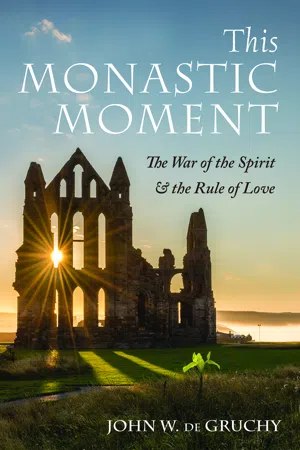![]()
1
INTO THE AFRICAN DESERT
O that I had wings like a dove,
to fly away and be at rest.
So I would escape far away
and take refuge in the desert.
(Psalm 54:7–8)
Let us go outside the camp and bear the abuse Jesus endured. For here we have not a lasting city, but we are looking for the city that is to come.
(Hebrews 13:13–14)
Anthony persuaded many to take up the solitary life. And so, from then on, there were monasteries in the mountains and the desert was made a city by monks, who left their own people and registered themselves for the citizenship in the heavens.
(St Athanasius)
Here, on the boundary of the church, was the place where the awareness that grace is costly and that grace includes discipleship was preserved. People left everything they had for the sake of Christ and tried to follow Jesus’ strict commandments through daily exercise. Monastic life thus became a living protest against the secularization of Christianity, against the cheapening of grace.
(Dietrich Bonhoeffer)
During our visit to Egypt in 1997, we attended a Sunday evening service in St Mark’s Coptic Cathedral in Alexandria. The huge building was overflowing with some three thousand worshipers; the service was conducted by several bishops, all of them monks. Pope Shenouda III gave a lengthy homily on angels and answered questions from the congregation on being a faithful Christian in an alien world. As patriarch of Alexandria, Shenouda was a successor to St Mark, the companion of St Peter. According to tradition, Mark brought Christianity to Egypt, became the first bishop of Alexandria, and died there as a martyr. Before the service we were taken to the crypt where Mark’s head is preserved; the rest of his relics, kept for centuries in Venice, are now beneath the Coptic Cathedral in Cairo. This is a potent reminder that the Coptic Church is built on its martyrs, the supreme model of discipleship.
Reflecting on that visit to Alexandria, and on how immediate the legacy of saints and martyrs remains for Coptic Christians, I imagine what it must have been like for Christians who lived there in the late third and early fourth centuries. By then, the Coptic (that is, Egyptian) church was strong, its patriarch occupied the second most important episcopal see in the catholic church after Rome, its “noble company of martyrs” were universally revered, and its theologians were becoming influential in the shaping of orthodoxy and combatting heresy.
But the Upper Nile region was also a place of intellectual ferment. Second only to Rome in the empire, Alexandria was famous as the “new Athens” because of its distinguished academy. This was the birthplace of Neoplatonism, a philosophy integrating Hellenistic and Oriental wisdom, sponsored by Emperor Julian in a “last great attempt of paganism to express itself in terms of a philosophical theology” that could counter Christian claims and promote both “science and life for the ancient mind.” There was also a strong gnostic presence in the region, some of it predating Christianity, and some that arose within the church itself in an attempt to accommodate Christian faith to pagan ideas. Indeed, among the ancient Coptic texts found at the important archeological site of Nag Hammadi in Upper Egypt in 1945–1946 were some that were a mixture of gnostic and Christian ideas dating back to the fourth century, including the Gospel of Truth and the Gospel according to St. Thomas.
Alexandria was also home to the largest Jewish community outside Palestine. It was there that the Old Testament was translated into Greek (called the Septuagint, or abbreviated LXX), and there that Philo (20 BCE—50 CE), the Jewish philosopher, visionary, and mystic, brilliantly blended Neoplatonism with Judaism. But in Christian circles, Alexandria was best known for the Catechetical School, which was established in the second century and made famous by its founding theologians, St Clement (150–215) and Origen (185–254), who attempted to bridge the gap between the world of biblical faith and Hellenistic philosophy. Attempts to do so had already begun in Rome when Justin Martyr (100–165) followed Philo and adapted the Stoic understanding of the logos, the sustaining power of the universe, to the Word “made flesh” in Christ.
It is also symbolic that we should begin our exploration of monasticism in Alexandria because there has always been a tension in its history between the city and the desert, as there has been between the academy and the monastery. When St Athanasius (296–373), patriarch of Alexandria, later wrote that the “desert was made a city by monks,” he was being intentional, for the first monastics were engaged in building a new Jerusalem, firmly convinced that “here we have no lasting city, for we are looking for the...
